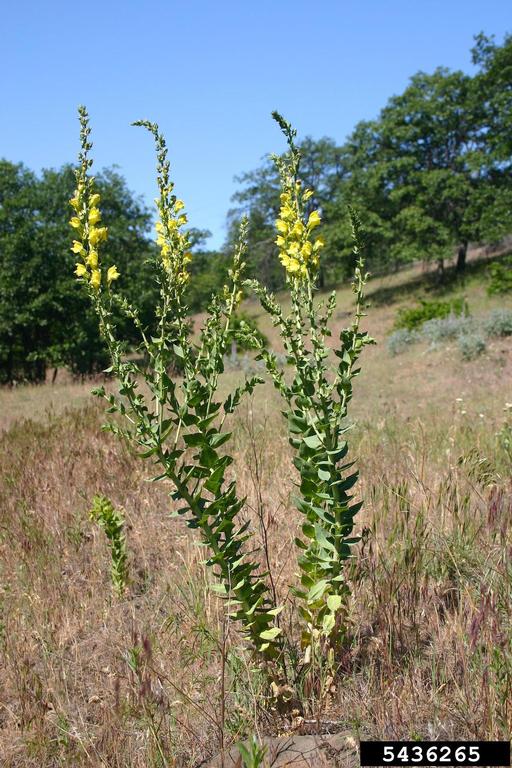Linaria dalmatica
Description
- Recognized by its striking yellow flowers, which resemble snapdragons, and its upright, waxy stems that can grow up to 3 feet tall.
- A perennial with a short lifespan, first-year plants form a rosette of leaves with a deep root system.
- Leaves: The leaves are blue-green, heart-shaped, and clasp around the stem, providing a distinct appearance.
- Roots: The mature plant can have a main taproot potentially growing over 1 meter deep with lateral rhizomes of up to 3 meters. Buds on these lateral roots form new stems.
- Stems: The stems and leaves of the plant are bluish-green, smooth, and waxy.
- Flowers: nearly identical to those of Common/Yellow toadflax, except the flowers of Dalmatian are larger.
Introduction and spread
- Introduced from the Mediterranean, likely as an ornamental around 1900.
- Found in at least 34 U.S. states and most Canadian provinces, with the widest distribution in the western regions.
- First recorded in Washington in the 1920s near Spokane (1926) and Bingen (1927).
- Thrives in full sun, well-drained soils, low-mid elevations with southern exposures.
- Grows in roadsides, rangelands, and disturbed areas.
- Reproduces by seed and vegetatively through creeping roots.
- Flowers from May to August, with seed pods, flowers, and buds present simultaneously.
- Mature plants can produce up to 500,000 seeds; seeds remain viable in soil for up to 10 years.
Consequences of invasion
- Outcompetes native vegetation, reducing biodiversity, and altering soil chemistry.
- Reduces livestock production in infested pastures and rangeland, particularly in the western U.S. and Canada. The plant has no value as food and crowds out valuable forage, posing a threat to local ecosystems.
- Reports indicate that it contains a poisonous glucoside, which may be harmful to livestock
- Extensive root systems makes it difficult to eradicate once established, and new infestations often begin by seed in disturbed or degraded vegetation areas, quickly increasing in size through vegetative reproduction.
Status in the CKISS region
- Dalmation toadflax has become widespread in the CKISS region and is currently classified as Strategic Control on the CKISS Annual Priority List.
- While it is not realistic to eradicate this species at the landscape level, this species may be treated at high priority sites (e.g. wildlife habitat, corridors of spread, adjacent to agricultural land, restoration sites, etc.) based on specific land management objectives.
- To learn more about how CKISS classifies and manages invasive species, see our Invasive Species Priority Lists page.
Integrated pest management options
Prevention
- Become PlantWise and learn about Grow Me Instead. Select alternative, non-invasive plants.
- Maintain healthy stands of grasses and other species.
- Regular tillage in cultivated areas controls spread.
- Clean equipment thoroughly to avoid moving seeds and root fragments to new sites.
Mechanical control
Mowing and Hand-Pulling:
- Prevent seed production by mowing and pulling before flowering.
- Repeated pulling in loose soils for a few years can control small infestations.
- Bag and cut stems of seeding plants before digging up roots to prevent seed dispersal.
Digging:
- Effective if soil is not too hard or rocky.
- Follow up for a few years to monitor for regrowth from roots and seedlings.
Mowing:
- Not effective as toadflax spreads by roots and seeds.
- Clean mowers and equipment to prevent spreading fragments.
Chemical control
- Chemical control may be an option. Consult a professional to determine whether this option is right for you.
- Spray in late spring when flowering or in fall before die-back.
- Always check product labels and follow directions.
Cultural control
- Intense, repeated cultivation for at least 2 years in crop situations.
- Clean equipment to prevent spreading root fragments.
- Grazing is ineffective due to toxic compounds and unpalatability to livestock.
Biological control
- Only use approved biological agents: four weevils, three moths, and a beetle.
- Five agents released in British Columbia.
- Long-term solution reducing reliance on mechanical and chemical methods.





